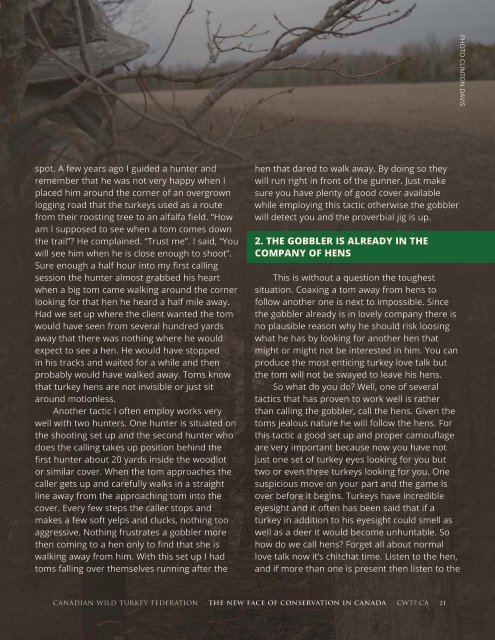CWTF 2017 Inaugural Member's Edition Magazine
CWTF is proud to share with you the Inaugural 2017 Member's Edition Magazine.
CWTF is proud to share with you the Inaugural 2017 Member's Edition Magazine.
You also want an ePaper? Increase the reach of your titles
YUMPU automatically turns print PDFs into web optimized ePapers that Google loves.
PHOTO CLINTON DAVIS<br />
spot. A few years ago I guided a hunter and<br />
remember that he was not very happy when I<br />
placed him around the corner of an overgrown<br />
logging road that the turkeys used as a route<br />
from their roosting tree to an alfalfa field. “How<br />
am I supposed to see when a tom comes down<br />
the trail”? He complained. “Trust me”. I said, “You<br />
will see him when he is close enough to shoot”.<br />
Sure enough a half hour into my first calling<br />
session the hunter almost grabbed his heart<br />
when a big tom came walking around the corner<br />
looking for that hen he heard a half mile away.<br />
Had we set up where the client wanted the tom<br />
would have seen from several hundred yards<br />
away that there was nothing where he would<br />
expect to see a hen. He would have stopped<br />
in his tracks and waited for a while and then<br />
probably would have walked away. Toms know<br />
that turkey hens are not invisible or just sit<br />
around motionless.<br />
Another tactic I often employ works very<br />
well with two hunters. One hunter is situated on<br />
the shooting set up and the second hunter who<br />
does the calling takes up position behind the<br />
first hunter about 20 yards inside the woodlot<br />
or similar cover. When the tom approaches the<br />
caller gets up and carefully walks in a straight<br />
line away from the approaching tom into the<br />
cover. Every few steps the caller stops and<br />
makes a few soft yelps and clucks, nothing too<br />
aggressive. Nothing frustrates a gobbler more<br />
then coming to a hen only to find that she is<br />
walking away from him. With this set up I had<br />
toms falling over themselves running after the<br />
hen that dared to walk away. By doing so they<br />
will run right in front of the gunner. Just make<br />
sure you have plenty of good cover available<br />
while employing this tactic otherwise the gobbler<br />
will detect you and the proverbial jig is up.<br />
2. THE GOBBLER IS ALREADY IN THE<br />
COMPANY OF HENS<br />
This is without a question the toughest<br />
situation. Coaxing a tom away from hens to<br />
follow another one is next to impossible. Since<br />
the gobbler already is in lovely company there is<br />
no plausible reason why he should risk loosing<br />
what he has by looking for another hen that<br />
might or might not be interested in him. You can<br />
produce the most enticing turkey love talk but<br />
the tom will not be swayed to leave his hens.<br />
So what do you do? Well, one of several<br />
tactics that has proven to work well is rather<br />
than calling the gobbler, call the hens. Given the<br />
toms jealous nature he will follow the hens. For<br />
this tactic a good set up and proper camouflage<br />
are very important because now you have not<br />
just one set of turkey eyes looking for you but<br />
two or even three turkeys looking for you. One<br />
suspicious move on your part and the game is<br />
over before it begins. Turkeys have incredible<br />
eyesight and it often has been said that if a<br />
turkey in addition to his eyesight could smell as<br />
well as a deer it would become unhuntable. So<br />
how do we call hens? Forget all about normal<br />
love talk now it’s chitchat time. Listen to the hen,<br />
and if more than one is present then listen to the<br />
canadian wild turkey federation the new face of conservation in canada cwtf.ca - 21


